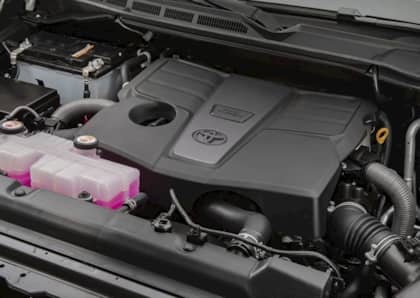EcoBoosted: Adding an Easy 60 HP to Ford’s Twin-Turbo 3.5L V6
In late 2015, the take-rate on EcoBoost-powered Ford F-150s was higher than 60 percent. As more and more consumers learned how capable the twin-turbo 3.5L V6 was (outpacing its V8 rivals in virtually every meaningful statistical category), they welcomed the possibility of having V8 power with V6 fuel economy. In the aftermarket, the design of the engine didn’t go unnoticed. Combining parallel turbochargers (one turbo feeding each bank), direct-injection and high compression with precise electronic controls overseeing the powertrain, it didn’t take long for calibrators to unlock big power gains with a few simple ECU tweaks.
Once again working alongside Gearhead Automotive Performance, this edition of our EcoBoosted series unveils the hidden horsepower potential of the 3.5L — and the ease at which it can be unleashed. We’ll strap a ’16 F-150 test mule to the dyno, upload a performance calibration onto the ECU, measure the gains of running higher octane and even see if there are any gains to be had from installing an aftermarket cold air intake system. This installment is the direct result of months’ worth of R&D conducted by the folks at Gearhead in an effort to make the 3.5L EcoBoost even more enjoyable to drive.
Dyno Verified Tuning
This ’16 model year, 12,000-mile 3.5L EcoBoost-powered F-150 was the test mule used for all of Gearhead Automotive Performance’s tuning R&D. For back-to-back, direct comparison results, all dyno testing was once again performed on Gearhead’s in-house 15000 series, all-wheel drive Dynocom chassis dyno. During each test, the Select-Shift six-speed automatic transmission was left in Fourth gear throughout the duration of the run (1.14:1 gear ratio).

Auto Octane Adjust: Version 2.0
As we all know, 93 octane isn’t available at every gas station across the country — and even your local filling station doesn’t always receive consistent batches of fuel. So what happens if you get a bad tank of gas or simply can’t get the good stuff when you take a trip? Frequently, aftermarket ECU tunes require a certain octane rating and don’t take into account the fact that you may not always be able to run that same octane rating in your truck.
Perhaps the most important aspect included in Gearhead’s tuning package is its retention of the factory “auto octane adjustment” feature present in the ECU. This feature allows the ECU to self-adjust according to the type of fuel being used (be it 87, 90 or 93 octane, etc.). But, not only does Gearhead keep this feature, they improve it. Owner Matt Robinson augments the factory auto octane adjustment strategy in a way that allows considerably more power to be made as you step up your octane rating (without changing the tune).

Octane Rating Makes a BIG Difference
For full disclosure, we’ll note that the truck’s stock baseline power numbers were collected after all ECU calibration changes (tuning tweaks) had concluded. The truck’s ECU was reflashed back to stock and was allotted ample time to cool down. However, a premium blend of gas (93 octane) was still present in the tank.
This means that — in conjunction with the EcoBoost ECU’s ability to make automatic adjustments according to the octane rating of the fuel the engine is using — the stock baseline number of 345 hp and 420 lb-ft would’ve been slightly lower with 87 octane in the mix. To sum things up, this graph represents how much power Gearhead’s F-150 produced while running a performance calibration on 87 octane (355 hp, 438 lb-ft) vs. what the truck made stock, but on 93 octane (345 hp, 420 lb-ft).

90 Octane Adds 23 HP
With exactly 5 gallons of 87 octane present in the tank, the folks at Gearhead added 5 gallons of premium (93 octane) and completed several driving cycles with the truck. With the two fuels effectively mixed, a 90 octane rating was the result. With 90 octane in the mix, the truck picked up an additional 23 hp, as well as 23 more lb-ft of torque, over the 87 octane performance tune. Notice that (just like in the previous graph) horsepower hangs around after its peak with the Gearhead tune vs. trailing off rapidly stock.

Octane Increase
To bring the octane rating up to 93, the appropriate ratio of Race Gas Race Fuel Concentrate was added to the tank. The truck was then subjected to the same driving cycle regimen to ensure the additive was adequately mixed. We’ll note that 10 ounces of additive was all that was needed.

+50 HP and a Broader Powerband
Back on the dyno, the truck picked up 50 hp from peak to peak vs. stock and also made considerably more torque at lower rpm (489 lb-ft at 2,800 rpm vs. 420 lb-ft at 3,300 rpm, stock). If you take a look at all of the area under the curve, you’ll notice that the Gearhead performance tune makes more power throughout the powerband as well, not to mention that (once again) peak horsepower trails off progressively once it peaks, as opposed to falling like a rock after 5,300 rpm in the stock calibration.

To take advantage of the newfound rpm range, the wide-open throttle shift points are raised in order to capitalize on this and also to better help accelerate the truck. According to Gearhead, more than an additional 50 hp can be made via tuning, but that means pushing the engine even harder — and Gearhead’s number one priority is keeping your EcoBoost as reliable as it was the day it left the dealership. We’ll take a 50 hp gain with no trade-off in drivability all day long!
Climbing the Ladder
This dyno comparison illustrates the climb in horsepower that takes place as you increase your octane rating. Keep in mind that all of these numbers were achieved with the same performance tune uploaded to the ECU.

K&N Drop-In
While the F-150’s ECU was still equipped with Gearhead’s performance file, this common drop-in replacement air filter from K&N was installed in place of the factory filter (PN 33-2385). K&N’s oiled drop-in replacement units are extremely popular due to providing an increase in airflow and being cleanable and reusable. The result of adding the K&N filter was a 3 hp increase at the wheels.

AFE Cold Air Intake
Following the K&N filter test, the guys at Gearhead scrapped the factory air intake assembly in favor of an aftermarket cold air intake system from AFE (Advanced Flow Engineering). Called its Magnum Force Stage 2 Pro 5R cold air intake (PN 54-12642-1B), it includes mandrel bent 3.5-inch diameter intake tubes, dual washable/reusable Pro 5R oiled air filters and is said to outflow the stock intake by 67 percent. It picked up 9 hp over stock.

10 Minutes or Less
Here, Gearhead Automotive Performance Co-Owner, Larz Bullard, begins the removal process of the factory intake assembly. All told, the AFE cold air intake system can be installed in approximately 10 minutes.

Stock vs. K&N Drop-In vs. AFE System
As expected, the AFE cold air intake freed up the most horsepower, ultimately pushing the F-150 past the 400-rwhp mark. However, the higher-flowing AFE system did yield more turbo whistle, which was very noticeable in the cab. If you’re not a fan of increased under hood noise (namely added turbo whine in the case of the EcoBoost), we’d suggest an intake system that makes use of a closed airbox.

The Gearhead Difference
Even though the EcoBoost tuning market is expanding every day, we believe Gearhead Automotive Performance has combined great power increases, awesome drivability and a level of octane safety into its tuning that is relatively unheard of at the present time. Currently, its 3.5L EcoBoost tunes are set for release in mid-April and will initially be available via SCT devices, with additional platforms potentially being supported in the near future.












